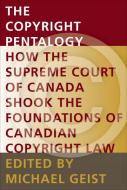 [Posted to michaelgeist.ca (CC-BY)(Link)] Copyright cases typically only reach the Supreme Court of Canada once every few years, ensuring that each case is carefully parsed and analyzed. As readers of this blog know, on July 12, 2012, the Supreme Court issued rulings on five copyright cases in a single day, an unprecedented tally that shook the very foundations of copyright law in Canada. In fact, with the decisions coming just weeks after the Canadian government passed long-awaited copyright reform legislation, Canadian copyright law experienced a seismic shift that will take years to sort out.
[Posted to michaelgeist.ca (CC-BY)(Link)] Copyright cases typically only reach the Supreme Court of Canada once every few years, ensuring that each case is carefully parsed and analyzed. As readers of this blog know, on July 12, 2012, the Supreme Court issued rulings on five copyright cases in a single day, an unprecedented tally that shook the very foundations of copyright law in Canada. In fact, with the decisions coming just weeks after the Canadian government passed long-awaited copyright reform legislation, Canadian copyright law experienced a seismic shift that will take years to sort out.
I am delighted to report that this week the University of Ottawa Press published The Copyright Pentalogy: How the Supreme Court of Canada Shook the Foundations of Canadian Copyright Law, an effort by many of Canada’s leading copyright scholars to begin the process of examining the long-term implications of the copyright pentalogy. The book is available for purchase and is also available as a free download under a Creative Commons licence. The book can be downloaded in its entirety or each of the 14 chapters can be downloaded individually. This is the first of a new collection from the UOP on law, technology and society (I am pleased to serve as the collection editor) that will be part of the UOP’s open access collection.
This book features fourteen articles on copyright written by independent scholars from coast to coast. The diversity of contributors provides a rich view the copyright pentalogy, with analysis of the standard of review of copyright decisions, fair dealing, technological neutrality, the scope of copyright law, and the implications of the decisions for copyright collective management.
While I am honoured to have served as editor (and to contribute my own work on the shift from fair dealing to fair use in Canada), each contributor was granted total freedom to address whatever aspects of the decisions they saw fit. There was no editorial attempt to prescribe a particular outcome or perspective. Indeed, the contributors differ in their views of the decisions and their support for the Court’s analysis and conclusions.
Contributions are grouped into five parts. Part one features three chapters on standard of review and the courts. Part two examines the fair dealing implications of the copyright pentalogy, with five chapters on the evolution of fair dealing and its likely interpretation in the years ahead. Part three contains two chapters on technological neutrality, which the Court established as a foundational principle of copyright law. The scope of copyright is assessed in part four with two chapters that canvass the exclusive rights under the copyright and the establishment of new “right” associated with user generated content. Part five features two chapters on copyright collective management and its future in the aftermath of the Court’s decisions. I’ll be writing more about the individual contributions in the days ahead and will provide more information on the plans for a conference on the copyright pentalogy being planned for the fall.




